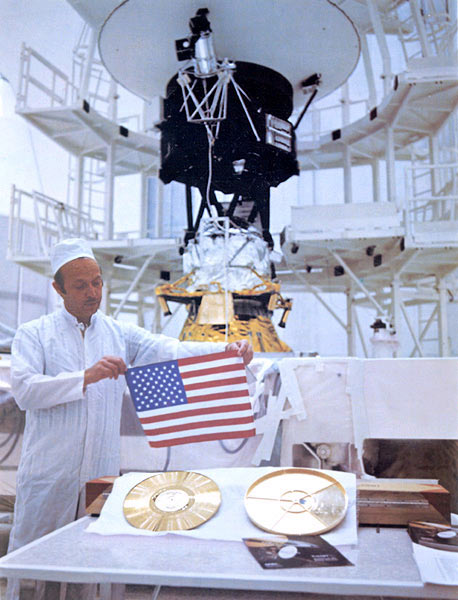American Flag Farthest From Home Is Leaving Solar System

This July 4th, U.S. citizens around the world may proudlydisplay American flags to celebrate Independence Day while away from home, butthey won't hold a candle to the farthest American flag in history, which isleaving the entire solar system behind on NASA's Voyager 1 spacecraft.
The spaceflying American flag is a not a huge version ofOld Glory, but will be the only one flying more than 10.5 billion miles (16.9 billion km) from Earth this Fourthof July. It is riding on Voyager 1, a 33-year-old space probe on theoutskirts of our solar system.
Another far-flung American flag is flying on Voyager 2,which is about 8.6 billion miles (13.8 billion km) fromEarth. Both Voyager 1 and Voyager 2 are on trajectories to leave the solarsystem behind after passing through a magnetic bubble-like region called theheliosphere.
A? NASA photo of the Voyager 2 American flag showsit to be a small U.S. standard packed alongside other mementos from Earth, likethe iconic golden record that were also launched the spacecraft and containmessages from Earth for any extraterrestrials that may find them.
?We were extraordinarily proud of what we were doing as alaboratory, as a part of NASA and as a country and we felt it was important tomake a statement to that effect,? said Jet Propulsion laboratory scientist JohnCasani, NASA's Voyager project manager at the time it was launched, in astatement provided to SPACE.com this week. ?I?m gratified that Voyager is stillsailing out there, bearing America?s colors. What it represents to us is anaffirmation of the pride we had at that time."
Voyager 2's space flag is a 16-inch (40-cm) long versionof the Stars and Stripes made of Dacron that engineers painstakingly sewed intothe insulating blankets of the Voyager 2 spacecraft, which launched in 1977 ona tour of the solar system's gas giant planets. A similar flag is flying on theVoyager 1 spacecraft, which also launched in 1977. [Voyagermission photos.]
The American flags riding the Voyager probes are not theonly distant U.S. standards out in space. Flags were planted on the moon byAmerican astronauts during the six Apollo lunar landings in the late 1960s andearly 1970s. NASA probes to Mars and elsewhere also include the U.S. standard.
Get the Space.com Newsletter
Breaking space news, the latest updates on rocket launches, skywatching events and more!
But the two Voyagerprobes are currently the farthest human-built objects fromEarth, making their American flags the most distance from U.S soil. The probes'signals take nearly 13 hours to travel to NASA's worldwide Deep Space Networkof listening antennas and back.
NASA launched both spacecraft in the summer of 1977, butonly Voyager 2 took a so-called "grand tour" of the solarsystem when it visited the gas giant planets Jupiter, Saturn,Uranus and Neptune in the 1980s by taking advantage of a rare planetaryalignment that occurs once every 176 years. Voyager 1 flew past Jupiter andSaturn.
On June 28, Voyager 2 hit a major milestone when itmarked the 12,000th day of its mission. Voyager one, which launched later than itscounterpart, will hit the same milestone on July 13.
?I?m proud of the people who worked on this and put somuch of their life and energy into building, developing and flying that thing,"Casani said. "They did it right.?
Join our Space Forums to keep talking space on the latest missions, night sky and more! And if you have a news tip, correction or comment, let us know at: community@space.com.

Tariq is the Editor-in-Chief of Space.com and joined the team in 2001, first as an intern and staff writer, and later as an editor. He covers human spaceflight, exploration and space science, as well as skywatching and entertainment. He became Space.com's Managing Editor in 2009 and Editor-in-Chief in 2019. Before joining Space.com, Tariq was a staff reporter for The Los Angeles Times covering education and city beats in La Habra, Fullerton and Huntington Beach. In October 2022, Tariq received the Harry Kolcum Award for excellence in space reporting from the National Space Club Florida Committee. He is also an Eagle Scout (yes, he has the Space Exploration merit badge) and went to Space Camp four times as a kid and a fifth time as an adult. He has journalism degrees from the University of Southern California and New York University. You can find Tariq at Space.com and as the co-host to the This Week In Space podcast with space historian Rod Pyle on the TWiT network. To see his latest project, you can follow Tariq on Twitter @tariqjmalik.











